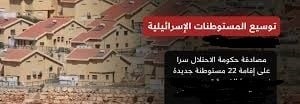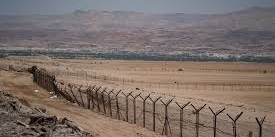By: Madeeha Al-A’raj
The National Bureau for defending land and resisting settlements ( nbprs ) stated in its latest weekly report , that Israeli Occupation Government continues the policy of displacement and ethnic cleansing in the West Bank (WB), especially in Hebron since 1967, where the Israeli Supreme Court rejects the petition submitted by 12 residential communities of Masafer Yatta, south of Hebron, known as: Jamba, Al-Markaz, Al-Halawa, Al-Fakhit, Al-Tabban, Al-Majaz, Maghair Al-Ubaid, Safa Al-Fawqa, Al-Tahta, Al-Tuba, Khallet Al-Daba, and Al-Mufqarah) against the occupation’s decision in 1981 to completely close the area and declare more than 30,000 dunams of its lands as firing areas, which means giving the occupying forces the green light to demolish these communities and displacing their residents at any time.
Commenting on the Israeli court’s decision, the European Union said that Israel as the occupying power must protect the Palestinian people, and not to displace them under international law. For its part, the Geneva Council for Rights and Freedoms described the decision to displace hundreds of Palestinians in the south of the West Bank in preparation for the transfer of their lands to the Jews as a blatant example of the policy of racial discrimination perpetrated by Israel, describing it as a war crime under the rules of international law and said that the approval reflected the complicity of the judicial system in Israel with the security and executive apparatus in perpetrating massive violation of human rights.
At the same time, the Israeli Civil Administration announced that the settlement subcommittee of the Higher Planning Council is holding a meeting next Thursday with the aim of depositing and approving new settlement plans that include 3,988 housing units in the settlements. The approval of these large settlement projects comes before the expected visit of the US President Joe Biden to Israel next June. According to it’s statement, new settlement plans will be deposited for 1,452 housing units in the following settlements:- Nokdim, 32 units, Ma’ale Adumim 16 units, Kdomim 286 units, Dolev 90 units, Emmanuel 170 units, Mavo Horon 110 units, Shaarei Tikva 192 units, Elkanah 500 units, and Nagohot 56 units. The final approval will take place at the same meeting on 2,536 housing units for a number of other settlements:- Dolev 364 units, Ma’aleh Makmash 114 units, Shivut Rachel 534 units, Nerea 168 units, Givat Ze’ev 136 units, Efrat 40 units, Tsofim 92 units, Rivava 64 units, Tel Menashe 107 units, Betar Illit 761 units, Kiryat Arba 156 units.
On the other hand, the occupation authorities announced the seizure of 22,000 dunums of the lands of the town of Al-Sawahrah Al-Sharqiah and Al-Nabi Musa, south of Jericho, under the name of a “Natural Reserve”. These lands are a natural extension of the population of the citizens in the East Jerusalem area. The announcement calls for the closure of the only road for Palestinians between Jerusalem, the Dead Sea and Jericho, known as the Abu George Road, which leads to isolating the Jericho Governorate and the Jordan Valley from Jerusalem, and paves the way for the displacement of the residents of Khan Al-Ahmar and the Bedouin communities in the area.
For its part, the Applied Research Institute “ARIJ” has recently issued a report stating that the occupation forces through the Coordination of Government Activities Unit announced on 24 April the establishment of a nature reserve on an area of 22,000 acres in the Jordan Valley. These targeted lands are located south of the ‘Almog settlement’ in the Jericho Governorate.
The Israeli Supreme Court has also approved the construction of a new settlement neighborhood in the heart of Hebron; this comes within a larger plan that includes the construction of 60 settlement units in the wholesale market area in Hebron. Carrying out the plan began several years ago before it was temporarily frozen, and this means that the Supreme Court refused to allow the implementation of this plan to be completed. Knowing that the “wholesale market” is located in the center of the city of Hebron, and the occupation forces have closed it since 1994 after the Ibrahimi Mosque’s massacre.
List of Israeli Assaults over the Last Week Documented by the National Bureau:
Jerusalem:
- Restoring a room belonging to Omar Simrin in order to establish a synagogue in the Wadi al-Rababa Neighborhood in Silwan. The area of Wadi al-Rababa is 210 dunums, in which more than 800 Jerusalemites live amd are threatened with displacement.
- Handing over a decision to demolish a horse facility in the Shuafat town, northeast of occupied Jerusalem, and a decision tothe family of Khaled Zaitoun to demolish their home in Silwan.
- Allowing settlers to storm the Al-Aqsa Mosque amid calls by the Temple Groups for the widest incursions into the mosque, and called for ‘celebration independence on the Temple Mount’ in reference to the Al-Aqsa Mosque. They also called to wave the flag of the Israeli occupation entity and to chant ‘the Israeli national anthem,’ while the Israeli terrorist Knesset member Itamar Ben Gvir said that now is the time to build a synagogue inside the courtyards of Al-Aqsa Mosque.
Hebron:
- Attacking homes of citizens in the Al-Qurainat area in the town of Surif while they were cultivating their lands in Khallet Ali Ghneim, they fired live bullets against them, causing the injury of 3 citizens.
- Bulldozing of 7 kilometer long of in the Janba Gatherings, Al-Halawa, and Al-Markaz in preparation for the closure of Masafer Yatta, and to prevent workers from reaching their workplaces inside the 1948 lands.
- Storming lands in the village of Al-Tawana, east of Yatta, and drawn a slogan of the ‘David Star’ on the lands of the citizens there.
- Injuring a shepherd sustained bruises in the shoulder after settlers attacking him from the settlement of “Itskha Rumman” newly established on the lands of citizens in Masafer Yatta.
Bethlehem:
- Bulldozing about 40 dunums of land in the ‘Al-Khor’ area, west of the village of Al-Jaba’a, near the military checkpoint leading to the ‘48’ areas, lands in the ‘Marah Tohma’ area, ‘Shaab Al-Batta’ site, west of the village, planted with olive trees and almonds.
- Destroying about 300 olive seedlings and agricultural crops in the Al-Khader town.
Nablus:
- Bulldozing lands in the Burin village, south of Nablus in favor of settlement expansion in the area.
- Uprooting 35 olive seedlings in Azmout village, east of Nablus.
- Bulldozing lands of the towns of Sebastia and Naqoura, Sebastia basin 4, and Naqoura, basin 12 to expand the Shaveh Shomron settlement.
- Demolishing 1,000-meter-long stone chains in Douma, and uprooted barbed wire and more than 100 olive trees over 20 years old.
Salfeet:
- Wounding Yosef Saleh, 75 with rubber-coated bullets in the chest, during thousands of settlers storming the Islamic shrines in the Kifl Haris town.
- Attacking civilian vehicles at the Za’tara military checkpoint, south of Nablus, which led to the damage of a number of them.
- Storming the Qarawat Bani Hassan town, west of Salfit, under the protection of the occupation forces, who closed the entrances to the town.
- Destroying 3 agricultural rooms on the northwestern side of the Kafr ad-Dik town in the Khallet al-Qamh area – Susia.
Jenin:
- Preventing farmers from accessing their lands near the separation fence erected over the lands of Rummana village, west of Jenin.
- Rejecting a petition to dismantle and transfer parts of the Apartheid Wall to avoid isolating farmers from their lands, filed by Palestinians from the towns of Qafin, Aqaba and Nazlet Issa in the northern West Bank after prevented them from accessing their lands.
Jordan Valley:
- Bulldozing scores of donums of land in Khirbat al-Farisiya in the northern Jordan Valley t expand the outpost that was established in the area about a year ago.
 المكتب الوطني للدفاع عن الارض ومقاومة الاستيطان منظمة التحرير الفلسطينية
المكتب الوطني للدفاع عن الارض ومقاومة الاستيطان منظمة التحرير الفلسطينية




